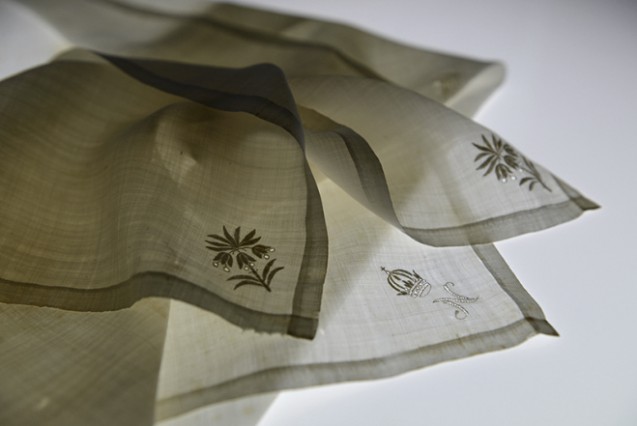During the meeting on Saturday 28th February 2015 at the State Archive of Lucca dedicated to the bicentenary of the departure of Napoleon from Elba, promoted in collaboration with the Mibact, the Province of Lucca, the Real Collegio, with support the Fondazione Cassa di Risparmio di Lucca and private sponsors, coordinated by journalist and television presenter Paolo Del Debbio, was shown a peculiar object forgotten by the Emperor, in the rush of the escape: his neckerchief.
Link to original article in Italian.
It is a sumptuous accessory, in fine white batiste, measuring approximately 70 × 70 cm, whose corners are embroidered with an “N” surmounted by the imperial crown and a decoration. It is the first time, after two centuries, that this garment has been presented to the public. The date for its presentation was chosen to coïncide with the anniversary of the final events of Napoleon on Elba. When, on the evening of February 26, 1815, the Emperor escaped from Elba to return to France, this neckerchief remained under one of the cushions in his bedroom.
One of the of the Emperor's servants immediately understood the importance of the find and kept it. For more than half a century, the tie was held by his family, who treated it like a relic of great value. In September of 1882, the last two descendants of the lucky servant decided to donate it to the English noblewoman Maria Luisa Bayard, who had married the general Manlio Bettarini, adjutant of Vittorio Emanuele II. Since then, the neckerchief remained in the Bettarini family until it passed to its direct heir, the Castellani family in Livorno.
This precious object represents one of the most important Napoleonic remains preserved in Tuscany and it is significant that it makes its first public appearance in Lucca, now recognized as one of the capitals of the Imperial Napoleonic system.
The discovery of its importance and identity is thanks to the historical research performed by the Lucca association “Napoleon and Elisa: from Paris to Tuscany” over many years, supported by the Fondazione Cassa di Risparmio di Lucca and Fondazione Livorno.
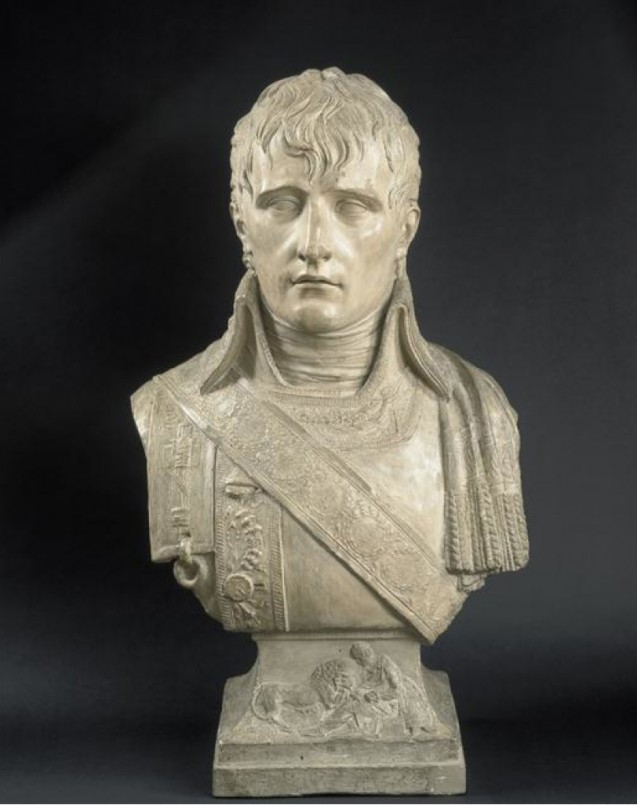 It is no coincidence that Bernard Chevallier, one of the world's foremost authorities in the field of Napoleonic study and honorary director of the Musée Nationaux de Malmaison et Bois-Préau, came from Paris to Lucca to talk about the importance of the discovery and to ensure its historical interest. His coming to Lucca demonstrates the great attention France pays to initiatives in Lucca; there was a talk in Paris recently on the subject at the Italian Consulate.
It is no coincidence that Bernard Chevallier, one of the world's foremost authorities in the field of Napoleonic study and honorary director of the Musée Nationaux de Malmaison et Bois-Préau, came from Paris to Lucca to talk about the importance of the discovery and to ensure its historical interest. His coming to Lucca demonstrates the great attention France pays to initiatives in Lucca; there was a talk in Paris recently on the subject at the Italian Consulate.
“It is very rare today to find yet unknown objects that belonged to Napoleon and it is even more difficult to find materials related to the Emperor's presence in Tuscany,” says Roberta Martinelli, former director of the National Museum of the Napoleonic Residences on the island of Elba. And today's Napoleonic neckerchief is presented to the public in excellent condition as a result of the work carried out by Domenica Digilio and Giacinto Cambini of the company “Restauro e studio tessile Lucca e Pisa”.
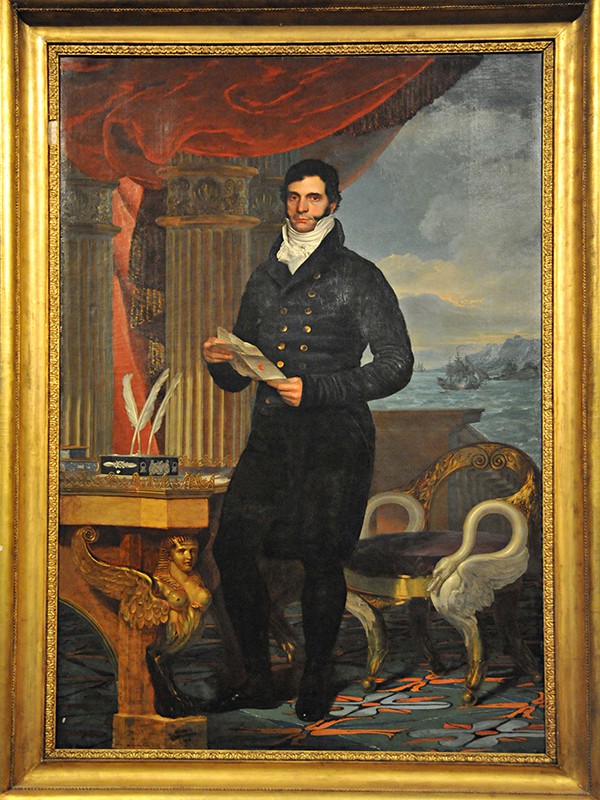 “This object is very rare” Chevallier writes in his report. “It is a neckerchief used by Napoleon during his stay on Elba. Neckerchiefs were made from large pieces of fabric, generally square, measuring 60 to 70 cm per side and knotted around the neck in many different ways, as can be seen in numerous early-nineteenth-century portraits of men. Neckerchiefs are never to be confused with handkerchiefs since the latter were always of smaller size”.
“This object is very rare” Chevallier writes in his report. “It is a neckerchief used by Napoleon during his stay on Elba. Neckerchiefs were made from large pieces of fabric, generally square, measuring 60 to 70 cm per side and knotted around the neck in many different ways, as can be seen in numerous early-nineteenth-century portraits of men. Neckerchiefs are never to be confused with handkerchiefs since the latter were always of smaller size”.
“For Napoleon, as for all the upper classes, the fabric with which such neckerchiefs were made was always India muslin or cambric, in other words, a very fine linen cloth. For example, at the ceremony of consecration and coronation the Emperor wore opulent neckerchiefs matched with lace collars and cuffs that cost the exorbitant sum of 4,000 francs.”
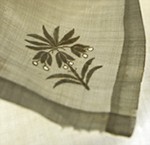 Who were the makers of these neckerchiefs? “Such accessories”, said the honorary director, “were supplied by Mademoiselles Lolive of “Beuvry et Compagnie”, the sole purveyors of linen to the Emperor and Empress. Their shop was in Paris at 61 rue Neuve de Petits Champs. The first known bill is dated August 1, 1805 and concerns the supply of 32 ells of muslin (an ell is roughly equivalent to 118 cm) for the sum of 768 francs. In addition the making of four dozen neckerchiefs from this fabric would cost 9 francs per dozen”.
Who were the makers of these neckerchiefs? “Such accessories”, said the honorary director, “were supplied by Mademoiselles Lolive of “Beuvry et Compagnie”, the sole purveyors of linen to the Emperor and Empress. Their shop was in Paris at 61 rue Neuve de Petits Champs. The first known bill is dated August 1, 1805 and concerns the supply of 32 ells of muslin (an ell is roughly equivalent to 118 cm) for the sum of 768 francs. In addition the making of four dozen neckerchiefs from this fabric would cost 9 francs per dozen”.
“Napoleon's first surviving wardrobe inventory dates from 1811, and under the heading number 42 are “seven dozen white neckerchiefs”. Each year, the “lingeriste” provided two dozen white neckerchiefs that had to last six years. Napoleon's linen was regularly washed by Mrs. Durand at a cost of 20 cents per neckerchief.
Invoices, now kept at the Archives Nationales, attest to the supply of many neckerchiefs, such as, for example, six dozen in 1808 and thirteen dozen in 1812 before leaving for the Russian campaign.”
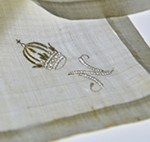 “During his two exiles, on the islands of Elba and of St. Helena, Napoleon was to bring with him many neckerchiefs, and the linen inventory, drawn up in 1821 after his death by the valet de chambre Marchand, lists a further six that were to be divided up among his brothers and sisters, each of them was to receive one as a souvenir. Apart from this example, we know of only one other identical neckerchief in existence, held at the Musée de l'Armée in Paris, which also bears the identical embroidered letter “N” surmounted by the imperial crown.”
“During his two exiles, on the islands of Elba and of St. Helena, Napoleon was to bring with him many neckerchiefs, and the linen inventory, drawn up in 1821 after his death by the valet de chambre Marchand, lists a further six that were to be divided up among his brothers and sisters, each of them was to receive one as a souvenir. Apart from this example, we know of only one other identical neckerchief in existence, held at the Musée de l'Armée in Paris, which also bears the identical embroidered letter “N” surmounted by the imperial crown.”


